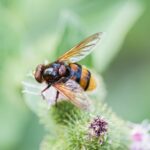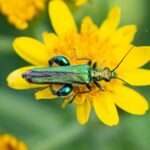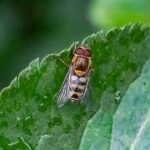Syrphus vitripennis
Syrphus vitripennis is a common and widespread hoverfly though rather more prone to seasonal fluctuations than the related S. ribesii. Also, it is seemingly more migratory, with the British population boosted by influxes from continental Europe in most summers. However, it seems to overwinter, and the first adults usually appear in April alongside the first ribesii but a couple of weeks later than the first torvus (which has hairy eyes).
Both sexes of vitripennis can be distinguished from ribesii by the presence of large microtrichia-free zones within the second basal cell of the wings. The hind femora of both sexes are 3/4 to 4/5 black (entirely yellow in female ribesii and rectus, and about 1/2 to 2/3 black in male ribesii).
Syrphus vitripennis averages a bit smaller than both ribesii and torvus and is more prone to having the yellow bands on tergites 3 & 4 broken in the middle. The very rare S. nitidifrons also has these bands divided, but even more so and more resembles Parasyrphus punctulatus or a Eupeodes species, and has the frons and mouth edge more extensively darkened than vitripennis. European specimens of ‘Syrphus rectus’ may be a form of S. vitripennis with the hind femora yellow except for a weak dark band around the middle.
Syrphus vitripennis is the least habitat-specific of our Syrphus species, probably because of its very mobile nature. The larvae attack aphids on a variety of bushes, shrubs and trees.






Leave a comment